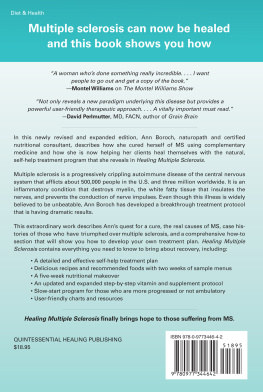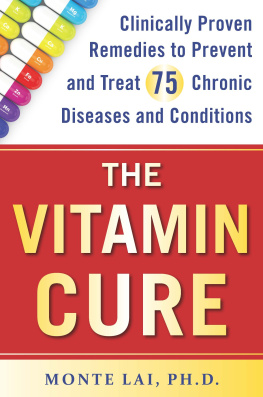The health information contained in this book is for educational purposes only and it is not intended as a medical manual. It represents my opinions, based on my personal experience with multiple sclerosis and the treatment with high-dose vitamin D. My intention is not to diagnose or treat any condition; rather, it is to educate and inspire you to explore a therapeutic approach that has enabled thousands of patients around the world to keep their autoimmune diseases in permanent remission. All warranties are disclaimed, without limitation, as well as liability for any damages arising from the use and/or application of the contents of this book, either directly or indirectly. The protocol discussed in this book is a medical treatment, and must always be carried out under the supervision of a qualified medical doctor.
Introduction
I did as much research as I could and I took ownership of this illness, because if you dont take care of your body, where are you going to live?
Karen Duff
If you picked up this book, chances are you have been or are in the process of being diagnosed with an autoimmune disease. You might even be following a treatment plan and taking the medications your doctor prescribed for your condition. But you are still searching for a solution, because the truth is that when it comes to autoimmune diseases, conventional medicine has failed miserably.
For my own condition, multiple sclerosis, the conventional options available today are powerful drugs that might or might not affect the progression of my disease, might or might not ease my symptoms, and would surely disrupt my life with their long list of harsh side effects. I took one of those drugs for almost two years, until I realized it was at best a palliative; it was far from being a solution.
My purpose in writing this book is to give you a straightforward, practical look into the protocol that has become my solution. I wont dwell on detailed explanations of what autoimmune disorders are, or talk extensively about conventional treatment options, diet plans or stress management. There are great resources available about each one of those subjects, and I recommend that you research them, for it makes a difference to be up-to-date about topics that can affect your condition. Ill talk briefly about those subjects, but only as they relate to my own experience. What I really want to share with you is the treatment I ultimately chose for myself. I want you to know how I found this treatment and what it has done for me in the eight years since my diagnosis. I want to enable you to choose it as well, if you so wish.
In 2002, a Brazilian neurologist, Dr. Cicero Galli Coimbra, noticed that, in order to raise their levels of vitamin D, patients with autoimmune diseases required higher doses than the average population. That was the beginning of what is presently known as the Coimbra Protocol.
In this book, I share my experience with the Coimbra Protocol. The information expressed here is based solely on what Ive learned as a patient, but it should be enough to give you an idea about this treatment plan, as well as allow your doctor a general understanding of it, should you request her assistance with the necessary medical tests. Let me reiterate: In order to follow this protocol, you must consult with a doctor who is knowledgeable in high-dose vitamin D treatment. At the end of the book, in Resources, youll find a link to the updated list of doctors. Afterwards, your own physician can request the laboratory tests, but you must have the supervision of a doctor who understands the Coimbra Protocol, someone you can turn to whenever you have questions about your treatment progress or personal test results.
Im from Brazil, where Dr. Coimbra practices. I am also a patient of Dr. Coimbra, though I have lived in New Mexico, USA, for the last 20 years. My own primary care physician, here in Albuquerque, has been ordering all my lab tests since I started taking high doses of vitamin D. This doctor is an MD, a conventional physician who works for a major hospital in the state; still, he has been very supportive of my choice of treatment. I believe that many doctors in this country would be just as supportive.
Presently, there are doctors in Canada, the United States, Italy, Portugal, Spain, Croatia, Argentina, Peru and Brazil prescribing the Coimbra protocol. As patients become aware of this option and request it, a growing number of doctors are becoming interested, making it available to more people with autoimmune diseases.
In chapters 4, 5, and 6, I tell my own story to give you a hands-on example of what to expect with this treatment. I talk about how often I have lab tests done, what my MRI results have shown through the years, how the diet works, etc. I try to keep it brief and to the point, because I know that what you are really looking for is an answer to the question: Can this be a solution for me?
In Chapter 10, there are testimonies from other patients who follow the Coimbra Protocol. During one of my trips to So Paulo, I had the privilege of personally meeting some of them; others I have known for quite some time from our Facebook groups. They are patients of relapsing-remitting multiple sclerosis, primary progressive multiple sclerosis, rheumatoid arthritis, Crohns disease, psoriatic arthritis, and psoriasis. Ill let their words speak for themselves.
As you read through the various sections, youll notice that this is not a book about learning how to live with a disease, nor about drastically changing your diet and lifestyle to achieve healing. This book is about a medical approach that can ease your symptoms, get you off your medications, and restore your health. Its about how powerful the right treatment can be. Sometimes its difficult to accept that such complex disorders can have such a simple solution as taking vitamin D, so let me share this story with you.
In 1595, the world faced a serious problem with sailing ships. Sailors were dying from a silent disease, with no apparent cause. In 1601, Captain James Lancaster decided to give a teaspoon of lemon every day to part of his crew. The result was that among the sailors that took the lemon, no one died. Among the ones who did not take the lemon, the mortality rate was about 40 percent. Captain James told everyone about it, but to no avail. In 1753, James Lind, a ships doctor, published a study comparing six different approaches to the prevention and treatment of the disease, which by then had been identified and named scurvy. In this study, he concluded: The most sudden and visible good effects were perceived from the use of oranges and lemons. Still, nobody thought about implementing the use of lemons in ships. In 1865, the intake of lemons was finally recommended as a prevention for scurvy, but because doctors did not understand how lemons cured the disease, this prevention practice was soon discredited. For the next 60 years, scurvy continued killing people despite having a known solution, with scientific research to back it up. This went on until 1932, when vitamin C was finally isolated and doctors understood that scurvy was caused by a deficiency of vitamin C, something easily solved with one teaspoon of lemon a day.







